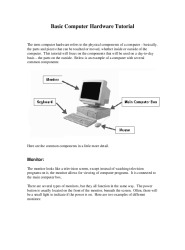Basic Computer Hardware Tutorial
Let's first look at the different parts that form a computer.
As you may already know, we can divide the logic of a machine into two parts: hardware and software. Let's first see the hardware.
This section is just an overview of the different parts: This course gives a more formal and detailed description of the various components of a computer. This chapter does not explain the internal workings of the pieces, but rather describes their roles and relationships.
Table of contents
- Monitor
- Keyboard
- Mouse
- Main Computer Box
- CD or DVD
- Disk slot
The processor
It is the most important piece in a computer. It is the electronic chip that is the brain of your machine. When a computer is running a program, the processor is responsible for reading each instruction one after the other and performing what is requested.
Memory
Memory is the second most important component in a computer. When programs are executed, they are first loaded into memory for processing. In addition, when you edit a text, it is located in the memory at the time of editing. In short, each task performed on a computer must temporarily store information in memory.
The hard drive
The hard drive is where the unused data and programs are stored. Unlike RAM, disk data is permanently recorded (unless severe hardware failure occurs). This is a real advantage over RAM. Unfortunately, the technology used for hard disks (mechanical) does not allow access as fast as RAM (electronic). That's why hard drives are not as expensive as RAM. The hard disks of today (2002) are measured in terms of gigabytes.
The keyboard and mouse
They are part of what are called input devices. The word peripheral means devices that are around the central machine, that is, around the processor and memory. To this word, the input word is added which means that the device is used to input data into the machine (input peripheral). Of course, there are also output peripherals for outputting data from the machine (eg screen, printer).
The keyboard and mouse, in particular, expect data from you. It is with these tools that you can communicate with the computer to ask it to run your programs and your daily tasks. For those who are real beginners, the keyboard is located in front of you with these many keys. (Each key has a symbol printed on it - like a typing keyboard). The mouse is located next to it. It is the device that usually has two or three buttons and is located on a small mat.
| Size : | 163.22 Kb |
| File type : | |
| Downloads: | 4858 |
| Created: | 2017-10-09 |
Warning: Trying to access array offset on false in /home/tutovnfz/public_html/article.php on line 233
Others Computer Tutorials
Software Above the Level of a Single Device
Others related eBooks about Basic Computer Hardware Tutorial
Computer basics for beginnersA basic computer tutorial is a step-by-step guide that is designed to provide beginners with an understanding of the fundamental components and functionalities of a computer....
Computer Fundamentals courseWith this course, you will learn how a computer works, it introduces you to assembly-level programming. You will be able to write a simple assembly language program. At the end of the tutorial, you’ll be able to understand the different types of information which may be stored in a computer memory...
Motherboard Study GuideDownload free pdf tutorial about the Motherboard computer, complet training document in 23 pages designated to beginner student level....
Computer and Information SciencesDownload free course Computer and Information Sciences, pdf file on 280 pages by Tadeusz Czachórski, Erol Gelenbe, Krzysztof Grochla, Ricardo Lent....
IEA International Computer and Information Literacy Study 2018 Assessment FrameworkDownload free course IEA International Computer and Information Literacy Study 2018 Assessment Framework, pdf file on 77 pages by Julian Fraillon, John Ainley, Wolfram Schulz, Daniel Duckworth, Tim Friedman....
Operating Systems: From 0 to 1Download free course Operating Systems: From 0 to 1, pdf file on 309 pages by Tu Do Hang....
Computer ArchitectureIn this tutorial, we briefly describe a basic computer architecture and principles of its operation ,a free PDF training course under 12 pages by Milo Martin & Amir Roth....
Getting the Most from LINQPad SuccinctlyDownload free course Getting the Most from LINQPad Succinctly, pdf file on 112 pages by José Roberto Olivas Mendoza....
Intelligent Human Computer InteractionDownload free course Intelligent Human Computer Interaction, pdf file on 227 pages by Patrick Horain, Catherine Achard, Malik Mallem....
Introduction to ARM Memory and Assembly LanguageDownload free pdf tutorial about ARM Memory and Assembly Language,training document for beginners....
